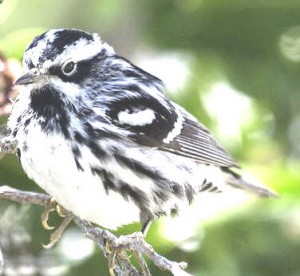The foraging habits of Black-and-white Warblers are unique among North American wood-warblers. Rather than gathering insects and spiders or their larvae from the foliage, twigs or small branches of trees or shrubs, Black-and-white Warblers mostly forage for their arthropod prey on the bark of major branches (preferably dead) and trunks of trees.This strategy is much like that of White- (Sitta carolinensis) or Red-breasted (S. canadensis) nuthatches. The foliage gleaning strategy used by other wood-warblers is comparable to strategies used by Brown-headed (S. pusilla) and Pygmy (S. pygmaea) nuthatches (Kricher 1995).
DISTRIBUTION. During the 1987-1992 field work seasons of the TBBA project, observers found breeding evidence for Black- and-white Warbler most concentrated in the Pineywoods, more scattered in the Post Oak Savannah and Blackland Prairies with a few records from the Rolling Plains, a small concentration in the southern Edwards Plateau and one confirmed record west of the Davis Mountains in the Trans-Pecos (see the region map in Lockwood and Freeman [2004]). No records were found below the 29th parallel. In all observers found about 23 confirmed, 150 probable and 62 possible breeding records.
In other parts of North America Black-and-white Warblers breed primarily in two swathes. One across Canada and the Great Lakes states from the Northwest Territories to New England, the maritime provinces and Newfoundland. The other swath extends from New England south and west through the Appalachian Mountains, then west to the Ozarks. In Oklahoma breeding is mostly concentrated to the eastern third of the state. This warbler winters in south Texas, along the south Atlantic coast, and in Florida, the West Indies, Middle America and northwest South America (Howell and Webb 1995, Kricher 1995, Lockwood and Freeman 2004, Revels 2004, Sauer et al. 2005).
SEASONAL OCCURRENCE. Northbound Black-and-white Warblers arrive in Texas from early or mid-March to mid-May as uncommon to common migrants. Breeding occurs from early April to early July,based on egg dates from April 11 to May 25. Most southbound migrants are present from late July to early November. In winter this warbler is rare to uncommon in south Texas (Oberholser 1974, Lockwood and Freeman 2004).
BREEDING HABITAT. Black-and-white Warbler breeds from near sea level to 600 m (2000 ft) in mixed forests of pine, oak, sweetgum and American beech in east Texas and in canyons overgrown with cedar, oak and shrubs on the edges of the Edwards Plateau (Oberholser 1974). Across the breeding range this warbler generally prefers mature, swampy forests (Kricher 1995).
The female builds the nest generally on the ground, usually against a tree, stump, log or rock or under a fallen branch, concealed from above. The nest is built om a base of dry leaf skeletons, interwoven with grasses, inner bark strips, rootlets and occasionally hair. The structure is lined with fine grasses, pine needles and fine rootlets. The cup diameter is 4.5-5 cm (1.8-2 in) and depth 3.8 cm (1.5 in) with a wall thickness of 2.5 cm (1 in; Harrison 1979, Kricher 1995).
The female usually lays 5 (range 4-6) smooth, white eggs, finely speckled with browns or purples (see Harrison [1979] for a photo of markings). She incubates the eggs for 10-12 days. Black-and-white Warbler pairs normally raise no more than one successful brood per year. They are common hosts to Brown-headed Cowbirds; (Molothrus ater). One nest was found with a female warbler incubating 8 cowbird eggs and 2 of hers (Harrison 1979, Kricher 1995
STATUS. Black-and-white Warblers are uncommon to common summer residents in east Texas and locally rare to uncommon on the Edwards Plateau (Lockwood and Freeman 2004). The TBBA map is similar to the area containing breeding symbols on the map in Oberholser (1974). North American Breeding Bird Survey data from 22 routes in Texas provide a population trend of about -6.5% change per year for the last quarter century. The statistically significant trend for the whole breeding range is much smaller (-1.2%; Sauer et al. 2005) The Texas trend estimate is worrisome, but it is derived from very small numbers, mostly less than 1 bird per route and not more than 3. Text by Robert C. Tweit (2007)
Lockwood, M. W. and B. Freeman. 2004. The TOS handbook of Texas birds. Texas A&M University Press, College Station.
Sauer, J. R., J. E. Hines, and J. Fallon. 2005. The North American Breeding Bird Survey, results and analysis 1966-2005. Version 6.2 2006. USGS Patuxent Wildlife Research Center, Laurel MD < http://www.mbr-pwrc.usgs.gov/bbs>

